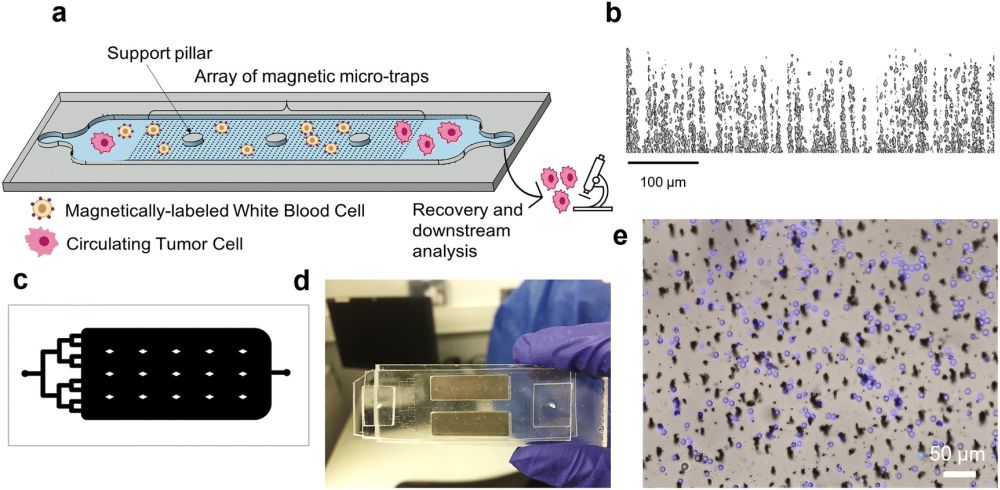
03 Oct Microfluidic device for immunomagnetic-based purification of tumor cells
Circulating tumor cells (CTCs) isolated from blood have high potentials to be used for early diagnosis of cancer as well as personalized treatment. However, CTCs are rare in the blood which hinders their widespread use for clinical applications. Microfluidic methods for isolating CTC have been the center of attention and made significant advances in recent years. For this week’s research highlight, we have selected one such advancement. In this article published in the Lab on a chip journal, a research group in France developed a PDMS-based microfluidic chip for immunomagnetic-based purification of circulating tumor cells from liquid biopsies. The proposed microfluidic device was able to work at high-throughput and process up to 7.5 mL of blood in less than 4hr.
” In this study, we developed an immunomagnetic-based microfluidic device, the MagPure chip, to achieve the negative selection of CTCs through the depletion of white blood cells (WBCs) and provide highly purified samples for subsequent analysis. We demonstrate that the MagPure chip depletes all magnetically labeled WBCs (85% of WBCs were successfully labeled) and ensures a CTC recovery rate of 81%.“, the authors explained.

“MagPure chip design and principle. (a) Schematic of the device for the negative selection of CTCs. Magnetically labeled WBCs are captured on magnetic micro-traps while CTCs are collected for downstream analysis. (b) Cross-section view of the composite membrane, located below the channel’s floor, integrating chain-like NdFeB microstructures (magnetic micro-traps). (c) Design of the trapping chamber (0.1 × 20 × 40 mm3) which consists of cascade input channels and one single straight output channel and diamond-shaped support pillars (2 × 1 mm2). All channels are 970 μm wide. (d) Picture of the compact system with the two milli-magnets located below the trapping chamber. (e) Composite microscopy image of captured WBCs on magnetic micro-traps integrated into the MagPure chip.” Reproduced under Creative Commons Attribution 3.0 Unported Licence from L. Descamps, J. Garcia, D. Barthelemy, E. Laurenceau, L. Payen, D. Le Roy and A. Deman, Lab Chip, 2022, Advance Article, DOI: 10.1039/D2LC00443G.
“This work demonstrated the value of emerging microfluidic and magnetophoretic technologies for characterizing liquid biopsy samples, an important research topic that will lead to changes in the paradigm of cancer diagnosis and management. Future work will consist in assessing the two-step workflow performances in a clinical context by isolation of CTCs from patient samples.“, the authors concluded.
The figures and the abstract are reproduced from L. Descamps, J. Garcia, D. Barthelemy, E. Laurenceau, L. Payen, D. Le Roy and A. Deman, Lab Chip, 2022, Advance Article , DOI: 10.1039/D2LC00443G under Creative Commons Attribution 3.0 Unported Licence
Read the original article: MagPure chip: an immunomagnetic-based microfluidic device for high purification of circulating tumor cells from liquid biopsies


